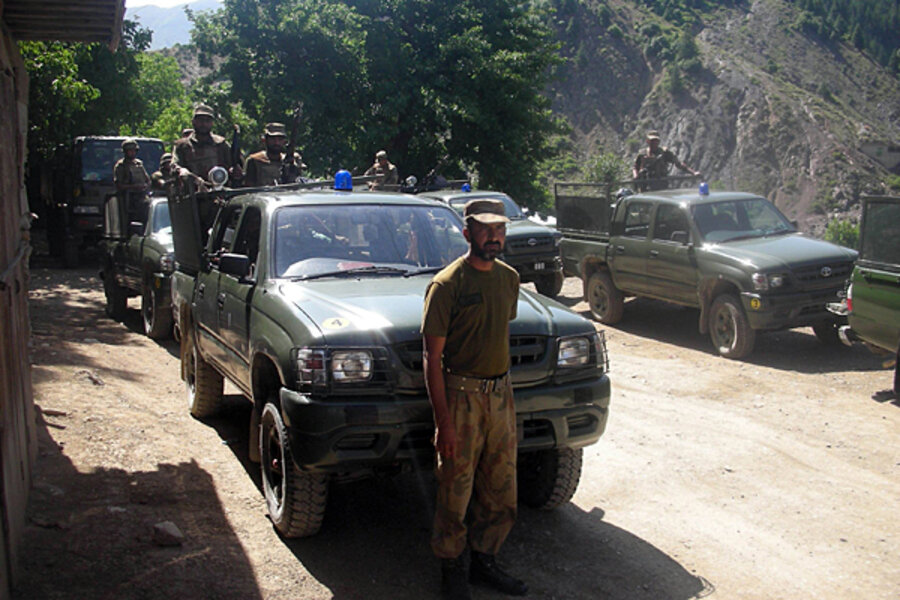How Pakistan's border region could get a few more good 'minutemen'
Loading...
| Dir and Peshawar, Pakistan
When hundreds of militants began pouring across the Afghan border into his district of Upper Dir last week, tribal elder Haji Malak Mutabar Khan gathered a few dozen neighbors, piled everyone into jeeps, and raced off to fight them.
Mr. Khan’s group of minutemen – known in Pakistan as a lashkar – held down the Taliban as more locals emerged to help. The next day, the Pakistan Army arrived and routed the militants back into Afghanistan.
Pakistan could use a few good tribesmen like Khan. The military says it’s worried about trying to hold recently cleared territory even as the US pushes for a major new operation in North Waziristan. Effective laskhars could do some of that work of stopping militants from hopping from haven to haven.
The problem: Most lashkars enlisted by the Pakistan government to aid in securing the border have been miserable failures, easily shut down by the militants.
“Where the government fails is that they do not back up the lashkars,” says retired Brig. Saad Mohammad. “This is a full-time job, to be a part of a lashkar…. He has to be given a living. If no one gives him that, he’ll put down his weapon and make it a part-time job.”
The lashkars also need to be formed before militants have had time in a region to kill tribal elders and scare tribesmen, he adds. Guns, ammo, and a little show of respect helps, too.
Khan sat down in the local police station for an interview, sporting a round cap, waistcoat, and a long, salt-and-pepper beard. His primary motivation for running the lashkar, he says, is to keep his community from having to flee their homes and end up in a tent city like so many civilians caught in the conflict here.
"These militants have attacked us in the past. And due to the previous militancy in the area, more than 2 million people migrated. We want to safeguard our land, buildings, schools, families, and other people of the area," says Khan.
Motivation to fight
Brigadier Mohammad points out that people in Dir (see map here) learned in 2009 what happened when militants made a home in areas like the nearby Swat Valley. At the first signs of their arrival that year, Khan rallied residents to pin down the militants. The lashkar surrounded them for three months, growing increasingly frustrated at losing their livelihoods waiting for the military to help. Finally, Pakistani planes helped end the standoff with bombs.
From that success, Khan gained a reputation as a leader and residents grew confident in their abilities. When Khan returned to the border last week to fight again, other residents quickly rallied to him.
At 4 a.m. on June 1, several hundred fighters poured out of Afghanistan’s Kunar Province into the Upper Dir areas of Shaltalo and Nusrat Dara. The fighters, says Khan, included former residents of Dir and Swat, as well as Afghanistan. They were speaking Pashto and Dari. The group overran schools that were being used by police as checkposts.
He and his men arrived in the evening and defended the area until the military arrived the next day. The Upper Dir police chief says the battle claimed the lives of 28 pro-government forces and more than 45 militants.
'If only they had the support of the military'
The incident prompted a diplomatic role reversal, with Pakistan complaining to Afghanistan about not doing enough to remove militant havens across the border. Over the past year, the US has pulled back from the Kunar region in Afghanistan.
Militants have ruthlessly cut down many such tribal leaders up and down the Afghan border to tamp down resistance from residents.
Tribesmen would rise up in large numbers against the militants if only they could be certain that the military would support them, says a tribal leader from South Waziristan who requests anonymity for fear of military authorities. He says locals suspect that the military at times helps the militants, discouraging tribesmen from risking their lives by joining a lashkar.
“Just give them logistics, weapons – they will do the job for you because now the tribal people are sick and tired of this,” he says of rooting out militants. “It will be done like this,” he adds, snapping his fingers.
Downside
But any widescale effort to arm residents could backfire by creating a new set of warlords, warns Mohammad, adding that any use of lashkars should come with a timeline, a plan for disarming them, and a sustained strategy.
He also argues that the deficiency in this fight hasn’t been in gunmen, but in civilian government engagement.
“Unfortunately in Pakistan and Afghanistan, there has been the overmilitarization of the counterinsurgency effort,” says Mohammad. “Counterinsurgency comprises of political reforms, economic packages, social reforms. [Instead] the complete effort has been given to the military.”





